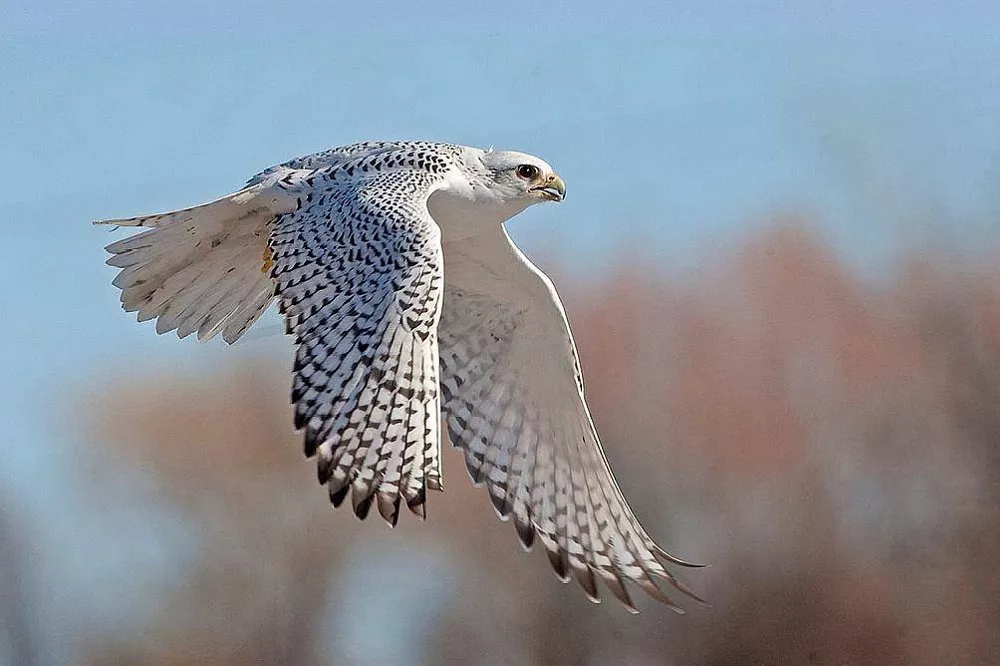Gyrfalcons are one of the largest and most impressive falcon species in the world. They are known for their incredible speed, agility, and hunting ability. These birds can be found throughout the Northern Hemisphere, from the Arctic tundra to the forests of Canada, and down through the Rocky Mountains into the western United States.
Gyrfalcons have a distinctive appearance, with powerful bodies, sharp talons, and piercing eyes. In this article, we will take a closer look at the physical characteristics that make these birds so unique.
Size and Shape
Gyrfalcons are large birds, with a wingspan of up to 63 inches and a length of up to 24 inches. They have a stocky build, with broad wings and a short tail. This body shape allows them to fly quickly and maneuver sharply while hunting.
Their legs and feet are also adapted for hunting, with sharp talons that are used to catch and kill prey. The talons are curved and can exert a crushing force of up to 450 pounds per square inch.
Coloration
Gyrfalcons have a range of color variations, depending on their location and age. Adults can be either white or dark gray, with black bars on their wings and tail feathers. Juveniles have dark brown or mottled plumage that gradually lightens as they mature.
Some subspecies of Gyrfalcon have more distinct color patterns, such as the Icelandic Gyrfalcon, which has a black hood and contrasting white face. Other subspecies, like the Greenland Gyrfalcon, have a more uniform white or gray coloration.
The underside of the Gyrfalcon’s wings is typically lighter than the rest of its body, with white or light gray feathers that contrast with the darker upper wing feathers. This coloration provides camouflage when hunting from above, as the bird blends in with the sky.
Eyesight
One of the most remarkable features of the Gyrfalcon is its incredible eyesight. Like all falcons, Gyrfalcons have a specialized eye structure that allows them to see with incredible clarity and detail.
They have a high density of light-sensitive cells in their retinas, which enables them to see small prey from great distances. This keen eyesight also helps them to navigate through complex terrain while hunting.
Flight
Gyrfalcons are powerful flyers, capable of reaching speeds of up to 80 miles per hour during a dive. They use their broad wings to soar and glide over vast distances, searching for prey.
When hunting, Gyrfalcons rely on their speed and agility to catch their prey. They often hunt by flying low over open areas, scanning the ground for movement. Once they spot prey, they will fold their wings and plummet towards the ground, striking their target with powerful talons.
Habitat
Gyrfalcons are found in a range of habitats throughout the Northern Hemisphere. In the Arctic tundra, they can be found nesting on cliffs or rocky outcroppings. In more forested areas, they may nest in trees or on man-made structures like power poles.
During migration, Gyrfalcons can be seen flying over mountains and open plains, as they travel to their wintering grounds.
Conservation Status
Gyrfalcons are considered a species of least concern by the International Union for Conservation of Nature (IUCN). However, some subspecies, such as the Greenland Gyrfalcon, are listed as vulnerable due to habitat loss and hunting pressure.
Conclusion
Overall, the Gyrfalcon is an impressive and formidable bird of prey. With its powerful body, sharp talons, and incredible eyesight, it is well-adapted to life in the Northern Hemisphere. While these birds can be challenging to spot in the wild, their unique physical characteristics make them a true marvel of nature.
Related topics:
- What does a Gyrfalcon eat?
- Saker Falcon vs Gyrfalcon: How to Tell Them Apart?
- Gyrfalcon vs Goshawk: What’s the Difference?


 Facebook
Facebook  Instagram
Instagram  Youtube
Youtube 